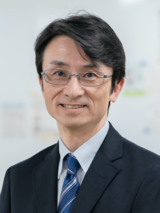
UEHARA, Hideyuki
| Affiliation | Department of Electrical and Electronic Information Engineering |
|---|---|
| Title | Professor |
| Fields of Research | Communication Engineering |
| Degree | Ph.D. (Keio University) |
| Academic Societies | IEICE / IEEE |
| uehara@ Please append "tut.jp" to the end of the address above. |
|
| Laboratory website URL | http://www.comm.ee.tut.ac.jp/wc/ |
| Researcher information URL(researchmap) | Researcher information |
Research
Master wireless, create communication technology friendly to humans and the earth.
Wireless systems have unlimited potential to enrich our lives. Based on communication theory, signal processing, and network architecture, we aim to create communication schemes and network control schemes, as well as novel wireless systems, that connect people to people, people to things, and things to things, and make effective use of limited wireless resources such as frequency and energy.
Theme1:Wireless Networks
Overview
In wireless networks, especially distributed autonomous networks, it is crucial to keep connectivity high for delivering more data with low latency, and also to save energy for longer time operation. Our goal is to design and build resource-efficient protocols for media access control and topology control used in the IoT and the associated digital society, where a vast number of things are connected.
Selected publications and works
[1] Mochammad Zen Samsono Hadi, Yuichi Miyaji, and Hideyuki Uehara, “An Energy-Efficient Mobile Group Clustering Protocol for Wireless Sensor Networks," IEICE Trans. Commun., vol. E101-B, no.8, Aug. 2018.
[2] Sho Sasaki, Yuichi Miyaji, and Hideyuki Uehara, “Energy Budget Formulation in Progress-Based Nearest Forwarding Routing Policy for Energy-EfficientWireless Sensor Networks,” IEICE Trans. Info. Sys., vol. E100-D, no. 12, pp. 2808-2817, Dec. 2017. DOI:https://doi.org/10.1587/transinf.2017PAP0010
[3] Sho Sasaki, Yuichi Miyaji, and Hideyuki Uehara, “A novel framework of routing policy for energy-efficient wireless sensor networks: Progress-based nearest forwarding,” IEICE Communications Express, 2016.
[4] Kenji Sugimoto, Yuichi Miyaji and Hideyuki Uehara, “Effect of Short NAV in Heterogeneous Ad-Hoc Networks to Mitigate Receiver Blocking Problem,” RISP International Workshop on Nonlinear Circuits, Communications and Signal Processing, 28PM1-4-2, Feb. 2015.
[5] Hiroki Matoba, Yuichi Miyaji and Hideyuki Uehara, “Demo: Multi-hop Wireless Communication System to Evaluate Direction Oriented Routing Protocol,” IEEE Vehicular Networking Conference, pp.129-130, Paderborn, Germany, Dec. 2014.
Keywords
Theme2:Wireless Sensing
Overview
Sensors that convert physical quantities to electrical signals can form sensing systems and create new services when they are equipped with processing and communication functions and when they are collected and connected. Our goal is to develop new sensing systems, such as localization and device identification of moving objects, by exploiting radio wave propagation characteristics as well as nonlinear characteristics of RF components.
Selected publications and works
[1] Ryota Shinoda, Ibuki Yoshitani, Yuichi Miyaji, and Hideyuki Uehara, “Feature Extraction From I/Q Signals For ZigBee Devices Identification,” IEICE Communications Express, vol. X10-B, no. 12, pp.-, Dec. 2021.
[2] Tomoaki Hiraoka, Yuichi Miyaji, and Hideyuki Uehara, “Device identification based on distortion of power amplifiers excited by swept sine,” IEICE Communications Express.
Keywords
Theme3:In-band Full-duplex Wireless
Overview
With the widespread use of wireless devices and sensors, and the rapid increase in communication traffic, wireless resources are in a critical shortage. In-band full duplex communications can double the capacity in principle compared to half duplex communications used in current wireless LANs, etc., however self-interference must be suppressed. Our goal is to develop a self-interference canceller based on the nonlinearity of radio-frequency (RF) circuits to realize in-band full-duplex wireless.
Selected publications and works
[1] Kazuki Komatsu, Yuichi Miyaji, and Hideyuki Uehara, “Weighted Least Squares With Orthonormal Polynomials and Numerical Integration for Estimation of Memoryless Nonlinearity ," IEEE Wirel. Commun. Letters, vol.99, issue 12, pp.2197-2201, Dec. 2020.
[2] Takahisa Fukui, Kazuki Komatsu, Yuichi Miyaji, and Hideyuki Uehara, “Analog Self-Interference Cancellation Using Auxiliary Transmitter Considering IQ Imbalance and Amplifier Nonlinearity," IEEE Trans. Wirel. Commun., vol.19, issue 11, pp.7439-7452, Nov. 2020.
[3] Kazuki Komatsu, Yuichi Miyaji, and Hideyuki Uehara, “Iterative Nonlinear Self-Interference Cancellation for In-Band Full-Duplex Wireless Communications Under Mixer Imbalance and Amplifier Nonlinearity," IEEE Trans. Wirel. Commun., vol.19, issue 7, pp.4424-4438, July 2020.
[4] Kazuki Komatsu, Yuichi Miyaji, and Hideyuki Uehara, "Basis Function Selection of Frequency-Domain Hammerstein Self-Interference Canceller for In-Band Full-Duplex Wireless Communications," IEEE Trans. on Wirel. Communi., vol.17, issue 6, pp.3768-3780, June 2018.
[5] Kazuki Komatsu, Yuichi Miyaji and Hideyuki Uehara, "Frequency-Domain Hammerstein Self-Interference Canceller for In-Band Full-Duplex OFDM Systems," IEEE Wireless Communications and Networking Conference, Mar. 2017.
Keywords
Title of class
Communication Engineering I / Communication Engineering II / Information Networks / Advanced Information and Communication Systems

